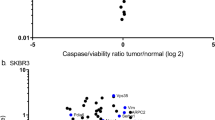Play all audios:

ABSTRACT Two murine Mabs VA1(IgG1) and VA2(IgG1) were produced against a bacterial fusion protein comprising glutathione S-transferase and five tandem repeats of the MUC1 protein. Using the
immunoperoxidase staining technique, VA1 detected 46/53 and VA2 detected 48/53 breast cancers and both also reacted with a range of other human epithelial carcinomas. In addition VA1 gave
weak reactions with normal breast tissues whereas VA2 was non-reactive and could be a relatively tumour specific antibody for breast cancer. The antibodies were also tested by ELISA-VA1
reacted weakly with glycosylated HMFG but strongly with deglycosylated HMFG, whereas VA2 reacted strongly with both forms of HMFG. The reactivities of the two Mabs with synthetic peptides of
the MUC1 tandem repeat were used to map the epitopes recognised by VA1 (amino acids RPAPGS) and VA2 (amino acids DTRPA). The use of fusion proteins provides another means of immunisation to
produce anti-tumour antibodies. Access through your institution Buy or subscribe This is a preview of subscription content, access via your institution ACCESS OPTIONS Access through your
institution Subscribe to this journal Receive 24 print issues and online access $259.00 per year only $10.79 per issue Learn more Buy this article * Purchase on SpringerLink * Instant access
to full article PDF Buy now Prices may be subject to local taxes which are calculated during checkout ADDITIONAL ACCESS OPTIONS: * Log in * Learn about institutional subscriptions * Read
our FAQs * Contact customer support SIMILAR CONTENT BEING VIEWED BY OTHERS TUMOR-ASSOCIATED AUTOANTIBODIES FROM MOUSE BREAST CANCER MODELS ARE FOUND IN SERUM OF BREAST CANCER PATIENTS
Article Open access 11 May 2021 CHARACTERIZATION OF HUMAN ANTI-EPCAM ANTIBODIES FOR DEVELOPING AN ANTIBODY–DRUG CONJUGATE Article Open access 14 March 2023 MONOCLONAL ANTIBODIES FROM HUMANS
WITH _MYCOBACTERIUM TUBERCULOSIS_ EXPOSURE OR LATENT INFECTION RECOGNIZE DISTINCT ARABINOMANNAN EPITOPES Article Open access 12 October 2021 AUTHOR INFORMATION AUTHORS AND AFFILIATIONS *
Austin Research Institute, Austin Hospital, Heidelberg, Victoria, Australia V Apostolopoulos Authors * V Apostolopoulos View author publications You can also search for this author inPubMed
Google Scholar * P-X Xing View author publications You can also search for this author inPubMed Google Scholar * JA Trapani View author publications You can also search for this author
inPubMed Google Scholar * IFC McKenzie View author publications You can also search for this author inPubMed Google Scholar RIGHTS AND PERMISSIONS Reprints and permissions ABOUT THIS ARTICLE
CITE THIS ARTICLE Apostolopoulos, V., Xing, PX., Trapani, J. _et al._ Production of anti-breast cancer monoclonal antibodies using a glutathione-S-transferase-MUC1 bacterial fusion protein.
_Br J Cancer_ 67, 713–720 (1993). https://doi.org/10.1038/bjc.1993.131 Download citation * Issue Date: 01 April 1993 * DOI: https://doi.org/10.1038/bjc.1993.131 SHARE THIS ARTICLE Anyone
you share the following link with will be able to read this content: Get shareable link Sorry, a shareable link is not currently available for this article. Copy to clipboard Provided by the
Springer Nature SharedIt content-sharing initiative
